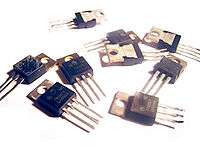78xx

The 78xx (sometimes L78xx, LM78xx, MC78xx...) is a family of self-contained fixed linear voltage regulator integrated circuits. The 78xx family is commonly used in electronic circuits requiring a regulated power supply due to their ease-of-use and low cost. For ICs within the family, the xx is replaced with two digits, indicating the output voltage (for example, the 7805 has a 5-volt output, while the 7812 produces 12 volts). The 78xx line are positive voltage regulators: they produce a voltage that is positive relative to a common ground. There is a related line of 79xx devices which are complementary negative voltage regulators. 78xx and 79xx ICs can be used in combination to provide positive and negative supply voltages in the same circuit.
78xx ICs have three terminals and are commonly found in the TO-220 form factor, although they are available in surface-mount, TO-92, and TO-3 packages. These devices support an input voltage anywhere from around 2.5 volts over the intended output voltage up to a maximum of 35 to 40 volts depending on the model, and typically provide 1 or 1.5 amperes of current (though smaller or larger packages may have a lower or higher current rating).
Advantages
- 78xx series ICs do not require additional components to provide a constant, regulated source of power, making them easy to use, as well as economical and efficient uses of space. Other voltage regulators may require additional components to set the output voltage level, or to assist in the regulation process. Some other designs (such as a switched-mode power supply) may need substantial engineering expertise to implement.
- 78xx series ICs have built-in protection against a circuit drawing too much current. They have protection against overheating and short-circuits, making them quite robust in most applications. In some cases, the current-limiting features of the 78xx devices can provide protection not only for the 78xx itself, but also for other parts of the circuit.
Disadvantages
- The input voltage must always be higher than the output voltage by some minimum amount (typically 2.5 volts). This can make these devices unsuitable for powering some devices from certain types of power sources (for example, powering a circuit that requires 5 volts using 6-volt batteries will not work using a 7805).
- As they are based on a linear regulator design, the input current required is always the same as the output current. As the input voltage must always be higher than the output voltage, this means that the total power (voltage multiplied by current) going into the 78xx will be more than the output power provided. The difference is dissipated as heat. This means both that for some applications an adequate heatsink must be provided, and also that a (often substantial) portion of the input power is wasted during the process, rendering them less efficient than some other types of power supplies. When the input voltage is significantly higher than the regulated output voltage (for example, powering a 7805 using a 24 volt power source), this inefficiency can be a significant issue. Buck converters may be preferred over 78xx regulators because they are more efficient and do not require heat sinks, but they are more expensive.
Individual devices in the series
There are common configurations for 78xx ICs, including 7805 (5 V), 7806 (6 V), 7808 (8 V), 7809 (9 V), 7810 (10 V), 7812 (12 V), 7815 (15 V), 7818 (18 V), and 7824 (24 V) versions. The 7805 is the most common, as its regulated 5-volt supply provides a convenient power source for most TTL components.
| Part number | Output voltage (V) | Minimal input voltage (V) |
|---|---|---|
| 7805 | +5 | 7.3 |
| 7806 | +6 | 8.3 |
| 7808 | +8 | 10.5 |
| 7810 | +10 | 12.5 |
| 7812 | +12 | 14.6 |
| 7815 | +15 | 17.7 |
| 7818 | +18 | 21.0 |
| 7824 | +24 | 27.1 |
Less common are lower-power versions such as the LM78Mxx series (500 mA) and LM78Lxx series (100 mA) from National Semiconductor. Some devices provide slightly different voltages than usual, such as the LM78L62 (6.2 volts) and LM78L82 (8.2 volts) as well as the STMicroelectronics L78L33ACZ (3.3 volts)
Unrelated devices
The LM78S40 from National Semiconductor is not part of the 78xx family and does not use the same design. It is a component in switching regulator designs and is not a linear regulator like other 78xx devices. The 7803SR from Datel is a full switching power supply module (designed as a drop-in replacement for 78xx chips), and not a linear regulator like the 78xx ICs.
See also
- List of LM-series integrated circuits
- List of linear integrated circuits
- LM317 — A similar linear regulator chip with a configurable output voltage.
- DC to DC converter — A class of devices which convert one DC voltage level to another. Linear regulators (and thus 78xx devices) are a form of DC to DC converter.
References
External links
- Reverse engineering a 7805 voltage regulator, detailed information about how a 7805 works and contains numerous reference links
- Examples
- Voltage Regulator Databook (Historical 1980), National Semiconductor
- LM78xx / LM340 (positive), Texas Instruments (TI acquired National Semiconductor)
- L78xx (positive), STMicroelectronics
- LM79xx (negative), Texas Instruments
- L79xx (negative), STMicroelectronics